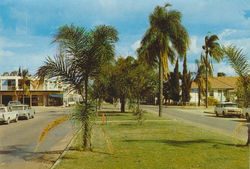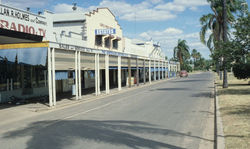
HISTORY OF THEODORE
History of Theodore and the Surrounding Area
Ancient Land, Deep Roots
Theodore sits on land originally inhabited by the Wulli Wulli people, who hunted and foraged in this fertile part of the Dawson Valley. While much of their early history was undocumented, their legacy lives on through artifacts and stories preserved at the ‘Keeping Place’ in Cracow, managed by Evolution Mining.
Pioneering Days
European settlement began with Joseph Thompson, who in 1850 secured leases over land that would one day become Theodore. Following Thompson’s death in 1857, fellow settler James Reid took over, ultimately amassing over 525 square miles of land. These early settlers laid the groundwork for future development.
Woolthorpe to Theodore: A Town is Born
In 1893 William Woolrych took up 13,000 acres which later formed Woolthorpe Station.
By 1920, Woolthorpe Station’s now 32,000 acres, were resumed by the Queensland Government under the Dawson Valley Irrigation Act, forming the foundation of modern-day Theodore. The ambitious Dawson Valley Irrigation Scheme followed - a first for Queensland - aiming to create 5,000 farms and support 50,000 people through a series of dams, canals, and irrigated plots with cotton being the main crop.
Below images: Anna Laurendet
 Dawson River Irrigation Scheme |  Theodore 1920. View from the water tower |
|---|---|
 Hotel Theodore 1938 |  The Boulevard Theodore 1930 |
The Dream of Castle Creek
The town began as Castle Creek in 1923, a model for irrigation-based development. With a modern power station, beautification program, and the planting of its now-iconic Boulevard palm trees, Castle Creek became the first town in the district to enjoy electricity, water, and other urban amenities.
Theodore Emerges
Development surged in 1924, with over 200 workers, new businesses, and social institutions like the Castle Creek Model Band, RSL, and various clubs forming. The Castle Creek State School opened in 1924, later expanding to accommodate growing student numbers. Due to poor road and rail access, supplies came from Rannes until the Dawson Line railway was extended to Castle Creek in 1927.
In December 1926, Castle Creek was officially renamed Theodore in honor of former Premier E.G. ‘Red Ted’ Theodore, a champion of the irrigation scheme.
Hardships
The 1930s brought various economic hardships. Flooding, prickly pear infestations, and a cotton price crash led to slow settlement growth. Some settlers shifted to dairying, supported by the Theodore Cheese Factory, which operated from 1940 to 1951.
A Royal Commission in 1933 reviewed the scheme, labeling it one of Queensland’s costliest at $17,000 per selector.
Despite setbacks, remaining settlers expanded cultivation and turned the district into a top producer of cotton and grazing products.
Modern Growth & Community Spirit
From the 1940s onward, Theodore continued to grow. New businesses emerged, a railway linked the town to Rockhampton, and an airstrip (the first in the Banana Shire!) was built. Clubs, sports grounds, and retirement facilities flourished. The community also fought for — and kept — their local hospital.
Further community and infrastructure developments included:
-
The Picture Theatre (1935–1999)
-
Airstrip (1937), later upgraded and community-funded in 2004
-
Bowls and Golf Clubs (1945, 1960)
-
Expansion of retail and services (1940s–50s)
-
Hospital and medical services (1952–present), with strong community involvement
Below images: https://queenslandplaces.com.au/theodore
 Rotary Park |  Theodore Shopping Strip |
|---|---|
 Main Street Theodore |  Main Street Theodore |
Making History
On December 28, 2010 Theodore made history by being the first town in Queensland to be totally evacuated due to rising floodwaters. Approximately 300 residents were all flown out by private helicopters.
Today’s Theodore
Modern Theodore is a thriving blend of rural charm and resilient community. Agriculture, tourism, and health care are major sources of employment.
Annual events like the Theodore Trail Ride for dirt motorbikes and the Bulls N Barrels Bonanza (which we are a proud sponsor of) bring locals and visitors together to celebrate the unique spirit of this Dawson Valley town.
 Theodore Water TowerWas painted by The Zookeeper and Drapl in May 2024. Photo by: Beryl Smith-Coventry |  Sacred Heart Catholic ChurchBuilt c1934. Photo by Greg Davis |
|---|---|
 Former Castle Creek TheatreBuilt in 1935 and operated as a picture theatre until 1999. Photo by Greg Davis |  Main St ThedorePhoto by Greg Davis |
 Main St TheodorePhoto by Greg Davis |